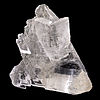- Mohs scale of mineral hardness
-
The Mohs scale of mineral hardness characterizes the scratch resistance of various minerals through the ability of a harder material to scratch a softer material. It was created in 1812 by the German geologist and mineralogist Friedrich Mohs and is one of several definitions of hardness in materials science.[1] The method of comparing hardness by seeing which minerals can scratch others, however, is of great antiquity, having first been mentioned by Theophrastus in his treatise On Stones, circa 300 BC, followed by Pliny the Elder in his Naturalis Historia, circa 77 AD.[2][3][4]
Contents
Minerals
The Mohs scale of mineral hardness is based on the ability of one natural sample of matter to scratch another. The samples of matter used by Mohs are all minerals. Minerals are pure substances found in nature. Rocks are made up of one or more minerals.[5] As the hardest known naturally occurring substance when the scale was designed, diamonds are at the top of the scale. The hardness of a material is measured against the scale by finding the hardest material that the given material can scratch, and/or the softest material that can scratch the given material. For example, if some material is scratched by apatite but not by fluorite, its hardness on the Mohs scale would fall between 4 and 5.[6]
The Mohs scale is a purely ordinal scale. For example, corundum (9) is twice as hard as topaz (8), but diamond (10) is four times as hard as corundum. The table below shows comparison with absolute hardness measured by a sclerometer, with pictorial examples.[7][8]
Mohs hardness Mineral Chemical formula Absolute hardness Image 1 Talc Mg3Si4O10(OH)2 1 
2 Gypsum CaSO4·2H2O 3 
3 Calcite CaCO3 9 
4 Fluorite CaF2 21 
5 Apatite Ca5(PO4)3(OH–,Cl–,F–) 48 
6 Orthoclase Feldspar KAlSi3O8 72 
7 Quartz SiO2 100 
8 Topaz Al2SiO4(OH–,F–)2 200 
9 Corundum Al2O3 400 
10 Diamond C 1600 
On the Mohs scale, graphite (a principal constituent of pencil "lead") has a hardness of 1.5; a fingernail, 2.2–2.5; a copper penny, 3.2–3.5; a pocketknife 5.1; a knife blade, 5.5; window glass plate, 5.5; and a steel file, 6.5.[9] A streak plate (unglazed porcelain) has a hardness of 7.0. Using these ordinary materials of known hardness can be a simple way to approximate the position of a mineral on the scale.[1]
Intermediate hardness
The table below incorporates additional substances that may fall between levels:
Hardness (Vickers)
Comparison between Hardness (Mohs) and Hardness (Vickers):[15]
Mineral
nameHardness (Mohs) Hardness (Vickers)
kg/mm2Graphite 1 - 2 VHN10=7 - 11 Tin 1½ - 2 VHN10=7 - 9 Bismuth 2 - 2½ VHN100=16 - 18 Gold 2½ - 3 VHN10=30 - 34 Silver 2½ - 3 VHN100=61 - 65 Chalcocite 2½ - 3 VHN100=84 - 87 Copper 2½ - 3 VHN100=77 - 99 Galena 2½ VHN100=79 - 104 Sphalerite 3½ - 4 VHN100=208 - 224 Heazlewoodite 4 VHN100=230 - 254 Carrollite 4½ - 5½ VHN100=507 - 586 Goethite 5 - 5½ VHN100=667 Hematite 5 - 6 VHN100=1,000 - 1,100 Chromite 5½ VHN100=1,278 - 1,456 Anatase 5½ - 6 VHN100=616 - 698 Rutile 6 - 6½ VHN100=894 - 974 Pyrite 6 - 6½ VHN100=1,505 - 1,520 Bowieite 7 VHN100=858 - 1,288 Euclase 7½ VHN100=1,310 Chromium 9 VHN100=1,875 - 2,000 See also
References
- ^ a b Encyclopædia Britannica. 2009. Encyclopædia Britannica Online. 22 Feb. 2009 "Mohs hardness."
- ^ Theophrastus on Stones
- ^ Pliny the Elder.Naturalis Historia.Book 37.Chap. 15. ADamas: six varieties of it. Two remedies.
- ^ Pliny the Elder.Naturalis Historia.Book 37.Chap. 76. The methods of testing precious stones.
- ^ Learn science, Intermediate p. 42
- ^ American Federation of Mineralogical Societies. "Mohs Scale of Mineral Hardness"
- ^ Amethyst Galleries' Mineral Gallery What is important about hardness?
- ^ Inland Lapidary Mineral Hardness and Hardness Scales
- ^ William S. Cordua (1998). "The Hardness of Minerals and Rocks". Lapidary Digest. http://www.gemcutters.org/LDA/hardness.htm. Retrieved 2007-08-19. Hosted at International Lapidary Association
- ^ L. I. berger "semiconductor materials" CRC press, 1996 ISBN 0849389127, p. 126
- ^ Weintraub E. (1911). "On the properties and preparation of the element boron.". J. Ind. Eng. Chem. 3 (5): 299–301. doi:10.1021/ie50029a007.
- ^ Solozhenko, V. L.; Kurakevych O. O.; Oganov A. R. (2008). "On the hardness of a new boron phase, orthorhombic γ-B28". Journal of Superhard Materials 30 (6): 428–429. doi:10.3103/s1063457608060117.. Open access:[1]
- ^ Zarechnaya, E. Yu.; Dubrovinsky, L.; Dubrovinskaia, N.; Filinchuk, Y.; Chernyshov, D.; Dmitriev, V.; Miyajima, N.; El Goresy, A. et al. (2009). "Superhard semiconducting optically transparent high pressure phase of boron". Phys. Rev. Lett. 102 (18): 185501. Bibcode 2009PhRvL.102r5501Z. doi:10.1103/physrevlett.102.185501. PMID 19518885.
- ^ Oganov A.R., Solozhenko V.L. (2009). "Boron: a hunt for superhard polymorphs". Journal of Superhard Materials 31: 285–291.. Open access: [2]
- ^ "Mindat.org". http://www.mindat.org/min-1911.html.
- Mohs hardness of elements is taken from G.V. Samsonov (Ed.) in Handbook of the physicochemical properties of the elements, IFI-Plenum, New York, USA, 1968.
- Cordua, William S. "The Hardness of Minerals and Rocks". Lapidary Digest, c. 1990.
Categories:- Materials science
- Mineralogy
- Hardness tests
Wikimedia Foundation. 2010.
